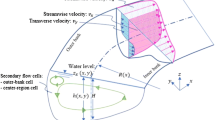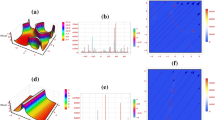Abstract
Shipping water events (SWE) occur when incident waves flood and propagate over the deck of maritime structures, usually during extreme wave climate. SWE can cause structural damage, unexpected overloading, human losses or even spills of products that are harmful to the environment. Therefore, the estimation of variables that help to predict the evolution of these events is highly helpful to lessen catastrophic consequences. In this regard, this work proposes a model-based approach to describe the spatiotemporal evolution of SWE on a fixed structure with a horizontal propagation domain. The approach is based on a model expressed as an advection-difussion equation with space-dependent nonlinear coefficients. To explore the suitability of the model, for characterizing the SWE evolution, its numerical response is compared with elevation data of SWE generated in a channel by incident regular wave trains. For the comparison, the model coefficients were estimated from an experimental data set with the use of an adaptive observer. The results of the comparison show that the response of the model allows to represent the physics of the analyzed SWE in an acceptable way. The advantage of using an adaptive observer for the estimation is that it can be used in further applications where the actual values of varying coefficients could be required in a reasonable computational time.








Similar content being viewed by others
References
Chen L, Wang Y, Wang X, Cao X (2020) 3d numerical simulations of green water impact on forward-speed wigley hull using open source codes. J Mar Sci Eng 8(5):327
Greco M (2001) A two-dimensional study of green-water loading. Ph.D. thesis, Norwegian University oF Science and Technology
Buchner B (2002) Green water on ship-type offshore structures. Ph.D. thesis, Delft University of Technology Delft
Hernández-Fontes JV, Vitola MA, Esperança PT, Sphaier SH, Silva R (2020) Patterns and vertical loads in water shipping in systematic wet dam-break experiments. Ocean Eng 197:106891
Miras T et al (2018) A staggered procedure for fluid-object interaction with free surfaces, large rotations and driven by adaptive time stepping. J Braz Soc Mech Sci Eng 40(4):1–20
Ogawa Y, Taguchi H, Ishida S (1997) Experimental study on shipping water volume and its load on deck. J Soc Naval Archit Japan 1997(182):177–185
Greco M, Bouscasse B, Lugni C (2012) 3-D seakeeping analysis with water on deck and slamming. Part 2. Experiments and physical investigation. J Fluids Struct 33:148–179
Hernández-Fontes JV, Esperança PTT, Graniel JFB, Sphaier SH, Silva R (2019) Green water on a fixed structure due to incident bores: guidelines and database for model validations regarding flow evolution. Water 11:2584
Silva DF, Esperança PT, Coutinho AL (2017) Green water loads on fpsos exposed to beam and quartering seas, part ii: Cfd simulations. Ocean Eng 140:434–452
Zhang X, Draper S, Wolgamot H, Zhao W & Cheng L (2018) Numerical investigation of effects of bow flare angle on greenwater overtopping a fixed offshore vessel
Chen L, Zhang X, Taylor PH, Draper S & Wolgamot H (2019) Cfd modelling to investigate design of a whaleback-type forecastle for greenwater protection
Rajendran S, Fonseca N, Soares CG (2016) Body nonlinear time domain calculation of vertical ship responses in extreme seas accounting for 2nd order froude-krylov pressure. Appl Ocean Res 54:39–52
Greco M, Lugni C, Faltinsen OM (2014) Can the water on deck influence the parametric roll of a fpso? A numerical and experimental investigation. Eur J Mech B/Fluids 47:188–201
Lakshmynarayanana P, Temarel P (2020) Application of a two-way partitioned method for predicting the wave-induced loads of a flexible containership. Appl Ocean Res 96:102052
Paramesh S, Rajendran S (2021) A unified seakeeping and manoeuvring model with a pid controller for path following of a kvlcc2 tanker in regular waves. Appl Ocean Res 116:102860
Sandeepkumar R, Rajendran S, Mohan R, Pascoal A (2022) A unified ship manoeuvring model with a nonlinear model predictive controller for path following in regular waves. Ocean Eng 243:110165
Rajendran S, & Guedes Soares C (2019) Effect of slamming and green water on short-term distribution of vertical bending moment of a containership in abnormal waves. In: Proceedings of the fourth international conference in ocean engineering (ICOE2018), pp 333–345
Rajendran S, Fonseca N, Soares CG (2016) Prediction of extreme motions and vertical bending moments on a cruise ship and comparison with experimental data. Ocean Eng 127:368–386
Rajendran S, Soares CG (2016) Numerical investigation of the vertical response of a containership in large amplitude waves. Ocean Eng 123:440–451
Stoker J (1957) Water waves: pure and applied mathematics. Interscience Publishers, New York
Goda K, Miyamoto T (1976) A study of shipping water pressure on deck by two-dimensional ship model tests. J Soc Naval Archit Japan 1976(140):16–22
Hu Z, Xue H, Tang W, Zhang X (2015) A combined wave-dam-breaking model for rogue wave overtopping. Ocean Eng 104:77–88
Hernández-Fontes JV, Vitola MA, Esperança PTT, Sphaier SH (2019) Analytical convolution model for shipping water evolution on a fixed structure. Appl Ocean Res 82:415–429
Fontes JV et al (2022) On the evolution of different types of green water events-part ii: Applicability of a convolution approach. Water 14(4):510
Hernández-Fontes JV, Hernández ID, Mendoza E, & Silva R (2020) Green water evolution on a fixed structure induced by incoming wave trains. Mech Based Des Struct Mach, pp 1–29
Hernández-Fontes JV, Vitola MA, Esperança PTT, Sphaier SH (2019) Assessing shipping water vertical loads on a fixed structure by convolution model and wet dam-break tests. Appl Ocean Res 82:63–73
Hernández-Fontes JV, Silva-Casarín R, & Mendoza E (2019) Capturing two consecutive green water events by convolution
Hernandez-Fontes J, Torres L, Mendoza E & Escudero M (2020) Identification of the advection-diffusion equation for predicting green water propagation. Ocean Eng (in press)
Bea R, Xu T, Stear J, Ramos R (1999) Wave forces on decks of offshore platforms. J Waterway Port Coastal Ocean Eng 125(3):136–144
Rajendran S, Fonseca N, Soares CG (2015) Simplified body nonlinear time domain calculation of vertical ship motions and wave loads in large amplitude waves. Ocean Eng 107:157–177
Zhang Q (2002) Adaptive observer for multiple-input-multiple-output (mimo) linear time-varying systems. IEEE Trans Auto Control 47(3):525–529
Hernández-Fontes JV (2018) An analytical and experimental study of shipping water evolution and related vertical loading. Ph.D. thesis, COPPE/UFRJ, Federal University of Rio de Janeiro, Rio de Janeiro, Brazil
Hernández-Fontes J, Torres L, Mendoza E, Escudero M (2020) Identification of the advection-diffusion equation for predicting green water propagation. Ocean Eng 214:107658
Saprykina Y, & Kuznetsov S (2009) Nonlinear mechanisms of formation of wave irregularity on deep and shallow water. Coastal Eng 2008; World Scientific Pub. Co. Pte. Lt: Singapore 357–369
Hernández ID, Hernández-Fontes JV, Vitola MA, Silva MC, Esperança PTT (2018) Water elevation measurements using binary image analysis for 2d hydrodynamic experiments. Ocean Eng 157:325–338
Acknowledgments
All the authors thank to DGAPA-UNAM for the financial support given trhough the PAPIIT project TA100421. J.V.H.F. thanks the support provided by “Gratificação de Produtividade Acadêmica (GPA) da Universidade do Estado do Amazonas, Portaria N\(^0\) 086/2021 - GR/UEA”. M.A.G.O. would like to thank UACM Project PI-CCyT-2021-12, PI-CCyT-2022-13 and CONACyT for their financial support.
Author information
Authors and Affiliations
Corresponding author
Additional information
Technical Editor: Erick Franklin.
Publisher's Note
Springer Nature remains neutral with regard to jurisdictional claims in published maps and institutional affiliations.
A Appendix A: Stability and robustness analysis of the used adaptive observer
A Appendix A: Stability and robustness analysis of the used adaptive observer
1.1 A.1 Stability and convergence analysis
Following the same steps as provided in [31], in first place take the system (10):
Define the observation and parametric errors \({{\tilde{\eta }}}={{\hat{\eta }}}-\eta \), \({{\tilde{\theta }}}={{\hat{\theta }}}-\theta \). Assuming that the actual parameters \(\theta \) are constant, then:
Taking \(\chi ={{\tilde{\eta }}}-\varvec{\Upsilon }{{\tilde{\theta }}}\), its derivative is
From (10), it is obtained that \({{\dot{\chi }}}=(L-K)\chi \). Therefore, if in the design \(\Re \{\lambda \{(L-K)\}\}<0\), then \(\lim _{t\rightarrow \infty }\chi =0\Rightarrow \lim _{t\rightarrow \infty }{\tilde{\eta }}=\varvec{\Upsilon }{{\tilde{\theta }}}\).
The dynamics of \(\varvec{\Upsilon }\) indicate that, if \(\phi \) is bounded, then \(\varvec{\Upsilon }\) is bounded. Then, from the adaptation law for \({{\hat{\theta }}}\), we obtain:
Therefore, if \(\varvec{\Upsilon }\) is bounded, then \(\Gamma \varvec{\Upsilon }^T\Sigma \varvec{\Upsilon }\) is bounded. If the persistent excitation condition
is fulfilled, then \({{\tilde{\theta }}}=0\) is exponentially stable. Given the previous reasons, then \(\chi \) converges to zero, leading exponentially \({{\tilde{\eta }}}\) to zero as well.
1.2 A.2 Robustness analysis of the observer
Following the same procedure as in [31], now consider that the system to be identified is subject to bounded additive uncertainties in the state equation \(\xi =\xi (t)\), in the parameters dynamics \(\delta _t\theta =\delta _t\theta (t)\) and measurement noise \(\nu =\nu (t)\):
where \(\eta _m\) is the measured state. Defining once again \(\chi ={{\tilde{\eta }}}-\varvec{\Upsilon }{{\tilde{\theta }}}\), the error dynamics of the state observation and parameter adaptation are
It is clear that \(\chi \) remains bounded if \(\xi \), \(\delta _t\theta \) and \(\nu \) remain bounded, and therefore \({{\tilde{\theta }}}\) remains bounded. If those are independent on \(\phi \) and with zero mean, that is \({\mathcal {E}}\{\xi \}=0\), \({\mathcal {E}}\{\delta _t\theta \}=0\), \({\mathcal {E}}\{\nu \}=0\), where \({\mathcal {E}}\) is the mathematical expectation operator, then as previously shown, \(\lim _{t\rightarrow \infty }{\mathcal {E}}\{\chi \}=0\) and \(\lim _{t\rightarrow \infty }{\mathcal {E}}\{{{\tilde{\theta }}}\}=0\). Therefore, \(\lim _{t\rightarrow \infty }{\mathcal {E}}\{{{\tilde{\eta }}}\}=0\) exponentially.
Rights and permissions
Springer Nature or its licensor holds exclusive rights to this article under a publishing agreement with the author(s) or other rightsholder(s); author self-archiving of the accepted manuscript version of this article is solely governed by the terms of such publishing agreement and applicable law.
About this article
Cite this article
González-Olvera, M.A., Torres, L., Fontes, J.V.H. et al. Characterizing water-on-deck propagation with a nonlinear advection-diffusion equation. J Braz. Soc. Mech. Sci. Eng. 44, 417 (2022). https://doi.org/10.1007/s40430-022-03718-1
Received:
Accepted:
Published:
DOI: https://doi.org/10.1007/s40430-022-03718-1




